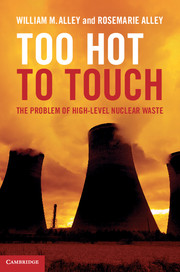Book contents
- Frontmatter
- Contents
- Acknowledgments
- List of units
- List of abbreviations
- Introduction
- Part I The problem
- 1 The awakening
- 2 Brainstorming
- 3 The ocean as a dumping ground
- 4 Radioactivity and atomic energy
- 5 The Cold War legacy
- 6 The peaceful atom and its wastes
- 7 Recycling
- 8 Dry cask storage
- 9 Interim storage
- 10 A can of worms
- 11 WIPP
- Part II The mountain
- Part III No solution in sight
- Appendix Discussion questions
- References
- Index
8 - Dry cask storage
from Part I - The problem
Published online by Cambridge University Press: 05 February 2013
- Frontmatter
- Contents
- Acknowledgments
- List of units
- List of abbreviations
- Introduction
- Part I The problem
- 1 The awakening
- 2 Brainstorming
- 3 The ocean as a dumping ground
- 4 Radioactivity and atomic energy
- 5 The Cold War legacy
- 6 The peaceful atom and its wastes
- 7 Recycling
- 8 Dry cask storage
- 9 Interim storage
- 10 A can of worms
- 11 WIPP
- Part II The mountain
- Part III No solution in sight
- Appendix Discussion questions
- References
- Index
Summary
Life is what happens to you while you're busy making other plans
Attributed to Allen Saunders, Betty Talmadge, John Lennon, and othersThe Maine Yankee was situated on Bailey Point, along the scenic Maine coast near the town of Wiscasset – according to locals, the State's prettiest village. From its startup in 1972, this 900 megawatt pressurized water reactor produced much of Maine's electric power until it was decommissioned in 1997. The Maine Yankee was one of the largest commercial nuclear power plants of its time. Originally licensed for 40 years, cracks were discovered in the steam generator tubes in 1995, and the plant was shut down for almost a year for repairs. Investigations by the Nuclear Regulatory Commission identified so many problems that the expense of repairing them became too costly. After only 25 years, the Maine Yankee was turned out to pasture.
What had not gone smoothly during the Yankee’s last years of operating life became a second-to-none decommissioning. Working together, stakeholders broke new ground in a number of areas that won international acclaim for innovation and excellence. The Maine Yankee was one of the first large commercial power reactors to complete its eight-year decommissioning safely and within budget. Firsts included the first ever use of explosives to safely demolish the reactor containment building. All plant structures were removed to three feet below grade. The site was then cleaned up radiologically to a significantly higher level than required by the Nuclear Regulatory Commission. Decommissioning also included the largest single campaign to move spent nuclear fuel from wet to dry storage. The Maine Yankee holds the record for the largest dry cask storage project for a decommissioned plant in the United States.
- Type
- Chapter
- Information
- Too Hot to TouchThe Problem of High-Level Nuclear Waste, pp. 112 - 121Publisher: Cambridge University PressPrint publication year: 2012



